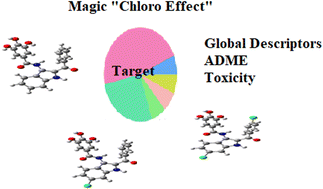Effect of “magic chlorine” in drug discovery: an in silico approach†
Abstract
The chlorine atom plays a vital role in drug design, yet the benefits of chlorine in 250 FDA-approved chlorine-containing drugs have not been studied properly. To see the “magic chloro” effect, computational studies have been carried out for 35 inhibitors, which are numbered as 12 complexes with (parent (–H), one chlorine, or two chlorine) substituents. The physicochemical properties are studied by conceptual density functional theory (CDFT). The pharmacokinetics, toxicity and metabolic properties of the studied inhibitors are estimated using chemoinformatics tools. SwissTargetPrediction is used to predict the multitarget activities of the studied inhibitors. Four FDA-approved drugs, diazepam, chloroquine, chloramphenicol, and bendamustine, are referenced to validate the studies. A higher HOMO–LUMO gap predicted high stability for the studied one and two chlorine-substituted analogues. Most of the studied inhibitors show “drug likeliness”, nontoxicity, and high gastrointestinal (GI) absorption. The addition of one or two chloro substituents has increased the physicochemical properties and stability of most of the inhibitors compared to the parent analogues, whereas the toxicity is not affected. No change in metabolic properties is observed on addition of one or two chlorine substituents. The multi-target activities of all the studied inhibitors are validated by the reference drugs and experimental results.



 Please wait while we load your content...
Please wait while we load your content...